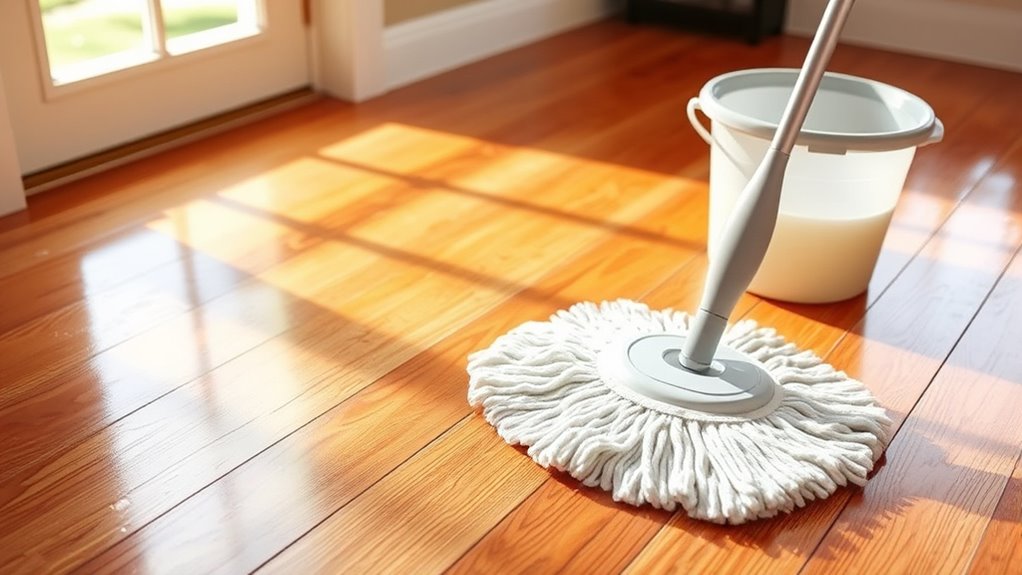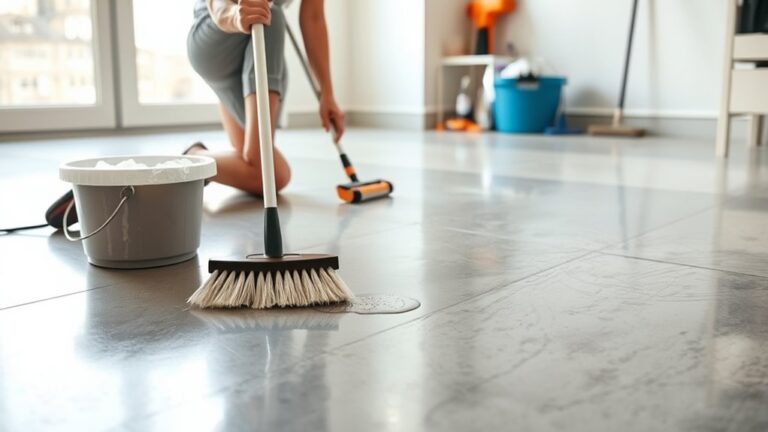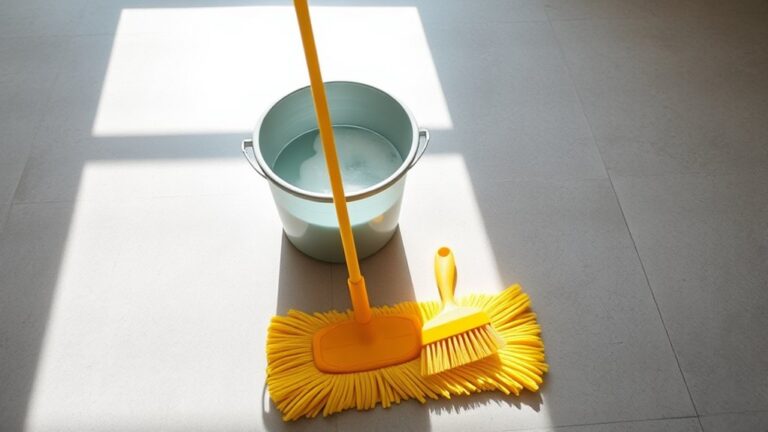To mop hardwood floors safely, use a microfiber mop lightly dampened with a pH-balanced, wood-safe cleaner—never soaking wet. Always mop along the wood grain in small sections, wringing out excess water frequently to prevent warping or finish damage. Prepare the floor by sweeping or vacuuming to remove grit first, and dry the floor quickly with good ventilation afterward. Following these steps keeps your 床 protected and beautiful. For deeper care techniques, you’ll find more essential tips ahead.
Understanding the Risks of Mopping Hardwood Floors
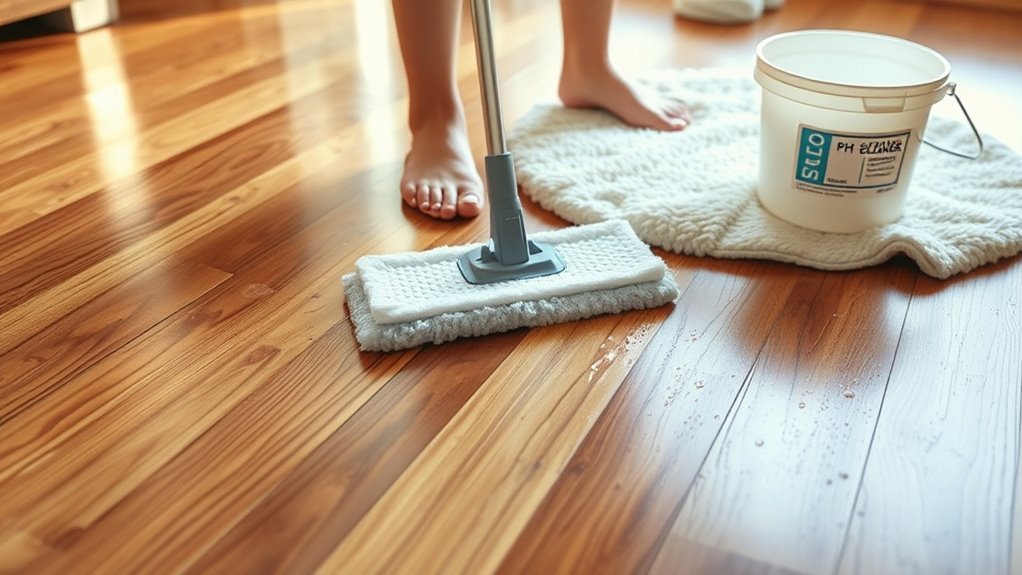
Although mopping hardwood floors is essential for maintaining their appearance, it comes with specific risks you need to understand. Excessive water exposure can penetrate the wood, causing warping, swelling, or permanent damage. Your floor finishes, designed to protect the wood, may degrade if overwhelmed by moisture, leading to dullness or peeling. You’ll want to avoid soaking the floor; instead, use a damp mop that limits water contact. Additionally, repeated exposure to water can weaken adhesive layers beneath the surface, compromising floor stability. By recognizing these risks, you gain control over your hardwood’s longevity and beauty. Taking a careful, measured approach to mopping guarantees you preserve freedom in your living space without sacrificing the integrity of your floors.
Choosing the Right Cleaning Products for Hardwood
When selecting cleaning products for hardwood floors, you need to prioritize formulas that are specifically designed to protect wood surfaces. Opt for eco friendly cleaners to minimize harmful chemicals that can degrade your floor’s finish and indoor air quality. Look for pH balanced solutions—these maintain the wood’s natural integrity without causing swelling or drying. Avoid harsh detergents, ammonia, or bleach, as they strip protective coatings and may lead to discoloration. Always choose products labeled safe for hardwood to guarantee they won’t leave residues or dull the surface. By carefully selecting the right cleaner, you maintain your floor’s beauty and durability, giving you the freedom to enjoy a spotless, healthy home without worrying about damage.
Preparing Your Hardwood Floors Before Mopping
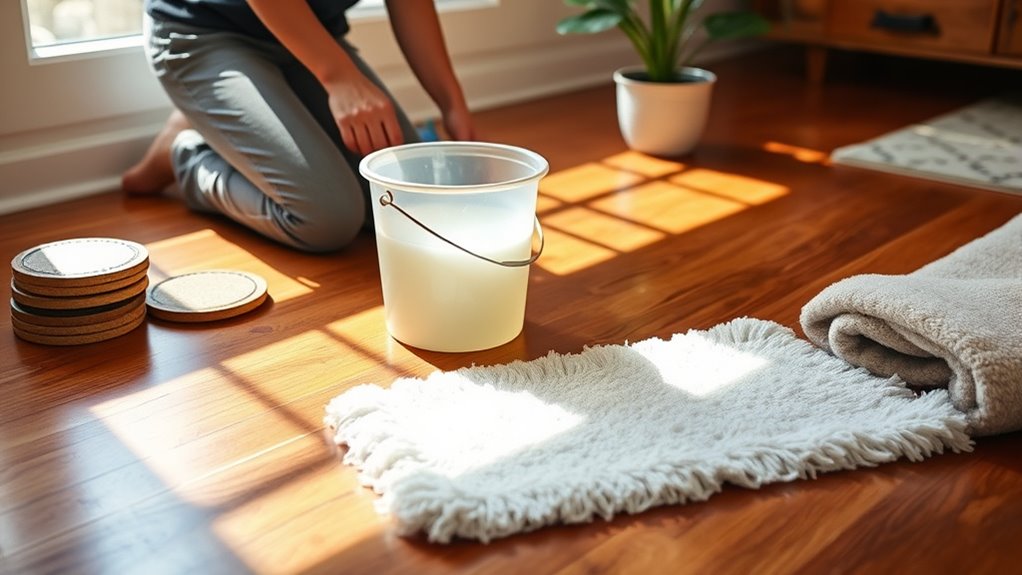
Selecting the right cleaner is only part of maintaining your hardwood floors; proper preparation before mopping plays a significant role in protecting them. Start by establishing a consistent cleaning schedule to prevent dirt buildup, which can scratch the surface. Before you mop, perform a thorough surface inspection to identify any debris, sticky spots, or damage. Use a soft broom or vacuum with a hardwood floor attachment to remove dust and grit, ensuring you don’t push dirt around. Check for any sticky residues that might require spot cleaning with a damp cloth. This methodical preparation safeguards the finish and extends your floor’s lifespan, giving you the freedom to enjoy spotless, well-maintained hardwood without worry. Skipping these steps risks damage and diminishes your floor’s natural beauty over time.
Selecting the Best Mop for Hardwood Surfaces
Because hardwood floors require gentle care, choosing the right mop is essential to avoid damage and maintain their finish. You want a mop that cleans effectively without soaking your floors. Microfiber mops and sponge mops are popular choices due to their gentle yet efficient cleaning.
| モップタイプ | 長所 | 短所 |
|---|---|---|
| マイクロファイバーモップ | Absorbs well, non-abrasive | Needs frequent washing |
| スポンジモップ | Soft, good for light spills | Can hold too much water |
| Steam Mop | Sanitizes without chemicals | Too much moisture risk |
| Cotton Mop | Natural fibers, affordable | Can leave lint |
| Flat Mop | Easy maneuverability | May miss corners |
Select a mop that balances safety and cleaning power, giving you freedom to maintain your hardwood floors with confidence.
How to Properly Damp Mop Hardwood Floors
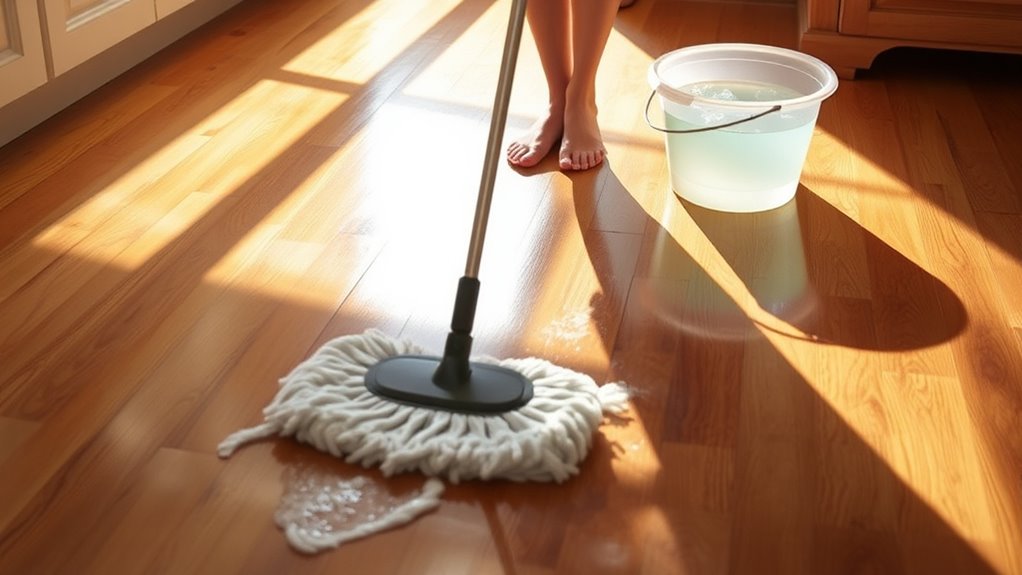
Now that you’ve picked the right mop for your hardwood floors, it’s important to use the correct damp mopping technique to protect the wood and finish. Follow these mop techniques to maintain freedom from damage and keep your floors pristine:
Using the right damp mop technique is key to protecting and preserving your hardwood floor’s finish and beauty.
- Lightly dampen your mop with water or a recommended hardwood floor cleaner—avoid soaking it.
- Mop in the direction of the wood grain to prevent streaks and guarantee even cleaning.
- Work in small sections, rinsing and wringing the mop frequently to avoid redistributing dirt.
- Allow floors to dry quickly by ventilating the room or using a dry microfiber cloth afterward.
Stick to a regular cleaning frequency, such as once a week, to prevent buildup and preserve your floor’s natural beauty.
Techniques to Avoid Excess Water Damage
To protect your hardwood floors, always use a damp mop rather than a wet one. Make sure to wring out the mop thoroughly to minimize water exposure. These simple steps help prevent excess moisture that can cause warping or damage.
Use Damp Mop Only
While mopping hardwood floors, you’ll want to use a damp mop rather than a soaking wet one to prevent water from seeping into the wood and causing damage. Understanding the difference between damp versus wet mops is key. Here’s how to proceed:
- Choose mop materials that absorb moisture without holding excess water, like microfiber or sponge mops.
- Lightly wet the mop, ensuring it’s moist but not dripping.
- Move the mop gently across the floor in smooth strokes to avoid pooling water.
- Allow floors to air dry quickly by keeping the room ventilated.
Wring Mop Thoroughly
Properly wringing your mop is essential to prevent excess water from damaging your hardwood floors. After soaking the mop, squeeze it firmly to remove as much liquid as possible. Excess moisture can seep into the wood, causing swelling, warping, or staining. To achieve effective mop wringing, twist the mop head with steady pressure, or use a mop bucket with a built-in wringer designed to extract water efficiently. Avoid dripping or leaving the mop overly wet, as this defeats the purpose of damp mopping. By controlling the moisture level through thorough wringing, you maintain your floors’ integrity while still cleaning effectively. Remember, a well-wrung mop gives you the freedom to clean safely without risking costly damage to your hardwood surfaces.
Drying Hardwood Floors After Mopping
One essential step after mopping hardwood floors is ensuring they dry quickly and evenly to prevent water damage. Proper drying techniques and moisture control preserve your floor’s integrity, so follow these steps:
Dry hardwood floors quickly and evenly after mopping to prevent water damage and preserve their integrity.
- Open windows and doors to increase air circulation.
- Use fans or a dehumidifier to speed up evaporation.
- Avoid walking on the floor until it’s completely dry to prevent dirt buildup or streaks.
- Wipe up any excess water with a dry, clean microfiber cloth immediately after mopping.
Tips for Maintaining Hardwood Floors Between Mops
Even if you mop regularly, maintaining your hardwood floors between cleanings is essential to preserving their appearance and durability. Start by committing to regular dusting; this prevents abrasive dirt and grit from scratching the surface. Use a microfiber dust mop or soft broom for best results. Pay attention to furniture placement—avoid dragging heavy pieces, as this can cause dents and scratches. Instead, use felt pads under furniture legs to distribute weight evenly and allow for easy movement. Additionally, keep an eye on spills and clean them promptly to prevent moisture damage. By combining these straightforward habits, you’ll protect your floors and extend the time between moppings, giving you more freedom to enjoy your space without constant upkeep.
When to Call a Professional for Hardwood Floor Care
If you notice deep scratches, warping, or persistent stains on your hardwood floors, it’s time to reflect on professional care. Certain cleaning tasks require specialized equipment and products that only experts provide. Calling a professional guarantees your floors receive the proper treatment, preserving their beauty and longevity.
Signs of Serious Damage
Although minor scratches and scuffs can often be managed with DIY methods, you’ll want to recognize signs of serious damage that require professional attention to prevent further deterioration. Here are key indicators to watch for:
- Water stains that penetrate deeply, causing discoloration or warping beyond surface cleaning.
- Deep gouges or cracks that expose wood fibers and compromise structural integrity.
- Finish peeling extensively, revealing bare wood vulnerable to moisture and dirt.
- Persistent minor scratches that accumulate and dull the floor’s overall appearance despite regular care.
If you notice any of these issues, it’s best to call a professional. They’ll assess the damage accurately and apply appropriate restoration techniques, helping you maintain your hardwood floors’ durability and beauty without risking further harm.
Specialized Cleaning Requirements
When your hardwood floors require more than routine cleaning, knowing when to call a professional becomes essential. If you face stubborn stains, deep scratches, or water damage, specialized products and techniques are necessary to avoid further harm. Professionals understand the precise formulations that won’t strip the finish or warp the wood. Additionally, they consider environmental factors like humidity and temperature, which can affect floor integrity and cleaning outcomes. If your floors have intricate finishes or you live in an area with extreme climate variations, relying on expert care prevents costly mistakes. By recognizing these specialized cleaning requirements, you maintain your floors’ longevity and beauty without sacrificing your freedom to enjoy them. Don’t hesitate to seek professional help when your hardwood demands more than just a mop and mild cleaner.
Benefits of Professional Expertise
Since hardwood floors require careful maintenance to preserve their appearance and durability, leveraging professional expertise can make a significant difference. Knowing when to call a professional guarantees your floors receive the right care without risk.
Here’s when expert cleaning and hardwood maintenance are essential:
- Deep stains or damage that regular mopping won’t fix.
- Refinishing or sealing to restore your floor’s protective layer.
- Persistent moisture issues causing warping or discoloration.
- Annual or biannual maintenance to extend floor life and maintain value.

